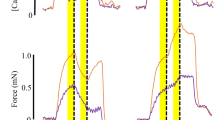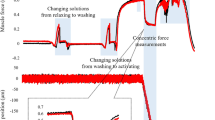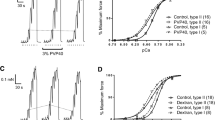Abstract
The effect of acidosis on Ca2+-activated force generation was studied in rabbit soleus, left ventricular, and adductor magnus muscles. Fibers were skinned (sarcolemma peeled off or mechanico-chemically disrupted) to facilitate direct manipulation and standardization of their intracellular ionic milieus according to bathing solution composition. Skinned single skeletal and small bundles of cardiac fibers were mounted in a photodiode force transducer and activated by immersion in buffered-Ca2+ bathing solutions. The magnitude of steady state isometric force at each [Ca2+] was determined at pH 7.0 and 6.5 (paired data) at both 1 mM and 10 mM Mg2+ in order to detect artifacts of errors in calculated [Ca2+]. All bathing solutions contained: 7 mM total EGTA [ethyleneglycol-bis-(β-amino-ethylether)-N,N′ tetra-acetic acid], 70 mM (Na++K+), 2 mM MgATP2− (Mg adenosine triphosphate), 15 mM CP2− (creatine phosphate), 15 units/ml CPK (creatine phosphokinase), imidazole (adjusted ionic strength to 0.15 M), and propionate anion at 23±1° C. Maximum tensions were similar at both [Mg2+]s but less at pH 6.5 than at pH 7.0, with the following order of mean magnitude of acidotic depression adductor>cardiac>soleus. The proportionately greater acidotic depression of submaximum (relative to maximum) forces that occurred only at 1 mM Mg2+ (cardiac>adductor>soleus) implicates acidotic depression of Ca2+-activated force as a major cause of decreased cardiac contractility.
Similar content being viewed by others
References
Aicken, C., Thomas, R.: Micro-electrode measurement of the intracellular pH and buffering power of mouse soleus muscle fibers. J. Physiol. (Lond.)267, 791–810 (1977)
April, E.: The myofilament lattice: studies on isolated fibers. IV. Lattice equilibria in striated muscle. J. Mechanochem. Cell Motil.3, 111–121 (1975)
Best, P. M., Donaldson, S. K. B., Kerrick, W. G. L.: Tension in mechanically disrupted mammalian cardiac cells: effects of magnesium adenosine triphosphate. J. Physiol. (Lond.)265, 1–17 (1977)
Bremel, D., Weber, A.: Calcium binding to rabbit skeletal myosin under physiological conditions. Biochem. Biophys. Acta376, 366–374 (1975)
Chen-Liu, R., Endo, M.: Effects of pH on calcium-activated tension of skinned muscle fibers. Biophys. J. (abstr.)13, 181a (1973)
Cingolani, H., Matiazzi, A., Blesa, E., Gonzalez, N.: Contractility in isolated mammalian heart muscle after acid-base changes. Circ. Res.26, 269–278 (1970)
Close, R. I.: Dynamic properties of mammalian skeletal muscles. Physiol. Rev.52, 129–197 (1972)
Donaldson, S., Kerrick, W.: Characterization of the effects of Mg2+ on Ca2+- and Sr2+-activated tension generation of skinned skeletal muscle fibers. J. Gen. Physiol.66, 427–444 (1975)
Donaldson, S., Best, P., Kerrick, W.: Characterization of the effects of Mg2+ on Ca2+- and Sr2+-activated tension generation of skinned rat cardiac fibers. J. Gen. Physiol. (1978)
Ebashi, S., Endo, M., Ohtusuki, I.: Control of muscle contraction. Q. Rev. Biophys.2, 351–384 (1969)
Ebashi, S., Masaki, T., Tsukui, R.: Cardiac contractile proteins. Adv. Cardiol.12, 59–69 (1974)
Fabiato, A., Fabiato, F.: Effects of magnesium on contractile activation of skinned cardiac cells. J. Physiol. (Lond.)249, 497–517 (1975)
Fabiato, A., Fabiato, F.: Effects of pH on the sensitivity of the myofilaments to calcium and on the releases of calcium from sarcoplasmic reticulum in skinned cells of cardiac and skeletal muscle. Biophys. J. (abstr.)16, 72a (1976)
Fuchs, F.: Chemical properties of the calcium receptor site of troponin as determined from binding studies. In: Calcium binding proteins (W. Drabikowski, H. Strzelecka-Bolaszewska, E. Carafoli, eds.), pp. 1–26. Warsaw: PWN-Polish Scientific Publishers 1974
Godt, R.: Calcium-activated tension of skinned muscle fibers of the frog. Dependence on magnesium adenosine triphosphate concentration. J. Gen. Physiol.63, 722–739 (1974)
Godt, R., Maughm, D.: Swelling of skinned muscle fibers of the frog. J. Gen. Physiol.19, 103–116 (1977)
Gordon, A., Godt, R., Donaldson, S., Harris, G.: Tension in skinned frog muscle fibers in solutions of varying ionic strength and neutral salt composition. J. Gen. Physiol.62, 550–574 (1973)
Hill, A. V.: The possible effects of the aggregation of the molecules of haemoglobin on its dissociation curves. J. Physiol. (Lond.)40, iv-vii (1910)
Jacobus, W., Taylor, G., Hollis, D., Nunnally, R.: Phosphorus nuclear magnetic resonance of perfused working rat hearts. Nature265, 756–758 (1977)
Katz, A., Hecht, H.: The early “pump” failure of the ischemic heart. Am. J. Med.47, 497–502 (1969)
Kerrick, W., Best, P.: Calcium ion release in mechanically disrupted heart cells. Science183, 435–437 (1974)
Kerrick, W., Donaldson, S.: The comparative effects of [Ca2+] and [Mg2+] on tension generation in the fibers of skinned frog skeletal muscle and mechanically disrupted rat ventricular cardiac muscle. Pflügers Arch.358, 195–201 (1975)
Kerrick, W., Secrist, D., Coby, R., Lucas, S.: Development of difference between red and white muscles in sensitivity to Ca2+ in the rabbit from embryo to adult. Nature260, 440–441 (1976)
Lorkovic, H.: Influence of changes in pH on the mechanical activity of cardiac muscle. Circ. Res.19, 711–720 (1966)
Nakamura, Y., Schwartz, A.: Possible control of intracellular calcium metabolism by [H+]: sarcoplasmic reticulum of skeletal and cardiac muscle. Biochem. Biophys. Res. Commun.41, 830–836 (1970)
Nakamura, Y., Schwartz, A.: The influence of hydrogen ion concentration on calcium binding and release by skeletal muscle sarcoplasmic reticulum. J. Gen. Physiol.59, 22–32 (1972)
Nikei, T., Noda, L., Morales, M.: Kinetic properties and equilibrium constant of the adenosine triphosphate-creatine transphosphorylase catalyzed reaction. J. Biol. Chem.236, 3202–3207 (1961)
Ng, M., Levy, M., Zieske, H.: Effects of changes of pH and of carbon dioxide tension on left ventricular performance. Am. J. Physiol.213, 115–120 (1967)
Pannier, J. L., Leusen, I.: Contraction characteristics of papillary muscle during changes in acid-base composition of the bathing fluid. Arch. Int. Physiol. Biochim.76, 624–634 (1968)
Pannier, J. L., Weyne, J.: The influence of lactate on the contractile properties of papillary heart muscle. Arch. Int. Physiol. Biochem.78, 101–110 (1970)
Pannier, J., Weyne, J., Leusen, I.: Effects ofP CO 2, bicarbonate and lactate on the isometric contractions of isolated soleus muscle of the rat. Pflügers Arch.320, 120–132 (1970)
Polemini, P., Page, E.: Magnesium in heart muscle. Circ. Res.33, 367–374 (1973)
Poole-Wilson, P. A.: Is early decline of cardiac function in ischemia due to carbon-dioxide retention. Lancet1, 1285–1287 (1975)
Poole-Wilson, P. A., Langer, G. A.: Effect of pH on ionic exchange and function in rat and rabbit myocardium. Am. J. Physiol.229, 570–581 (1975)
Potter, J.: Effect of Mg2+ on Ca2+ binding to myosin. Fed. Proc.34, 671 (1975)
Potter, J., Gergely, J.: The calcium and magnesium binding sites on troponin and their role in the regulation of myofibrillar adenosine triphosphatase. J. Biol. Chem.250, 4628–4633 (1975)
Robertson, S., Kerrick, W.: The effects of pH on submaximal and maximal Ca2+-activated tension in skinned frog skeletal fibers. Biophys. J. (abstr.)16, 73a (1976)
Rome, E.: Light and X-ray diffraction studies of the filament lattice of glycerol-extracted rabbit psoas muscle. J. Mol. Biol.27, 491–602 (1967)
Schädler, M.: Proportionale Aktivierung von ATPase-Aktivität und Kontraktionsspannung durch Calciumionen in isolierten kontraktilen Strukturen verschiedener Muskelarten. Pflügers Arch.296, 70–90 (1967)
Serur, J., Skelton, C., Bodem, R., Sonnenblick, E.: Respiratory acid-base changes and myocardial contractility: interaction between calcium and hydrogen ions. J. Mol. Cell. Cardiol.8, 823–836 (1976)
Solaro, J., Shiner, J.: Modulation of Ca2+ control of dog and rabbit cardiac myofibrils by Mg2+. Circ. Res.39, 8–14 (1976)
Tsien, R.: Possible effects of hydrogen ions in ischemic myocardium. Circulation53, (Suppl. I), 114–116 (1976)
Waddell, W., Bates, R.: Intracellular pH. Phys. Rev.49, 285–329 (1969)
Williamson, J. R., Schaffer, S., Ford, C., Safer, B.: Contribution of tissue acidosis to ischemic injury in the perfused rat heart. Circulation53, (Suppl. I), 13–126 (1976)
Wyman, J.: Allosteric effects in hemoglobin. Cold Spring Harbor Symp. Quant. Biol.28, 483–504 (1963)
Author information
Authors and Affiliations
Additional information
Supported by National Institute of Health grants HL 17373 and RR00374. Preliminary report: Biophysical J. (abs)17, 201a (1977)
Dr. Hermansen was a visiting scientist supported by Fogarty International Fellowship Grant TWO2230 from the National Institutes of Health and by the Perkins Fund of the American Physiological Society. Present Address: Institute of Work Physiology, Oslo, Norway
Rights and permissions
About this article
Cite this article
Bolitho Donaldson, S.K., Hermansen, L. & Bolles, L. Differential, direct effects of H+ on Ca2+-activated force of Skinned fibers from the soleus, cardiac and adductor magnus muscles of rabbits. Pflugers Arch. 376, 55–65 (1978). https://doi.org/10.1007/BF00585248
Received:
Issue Date:
DOI: https://doi.org/10.1007/BF00585248




